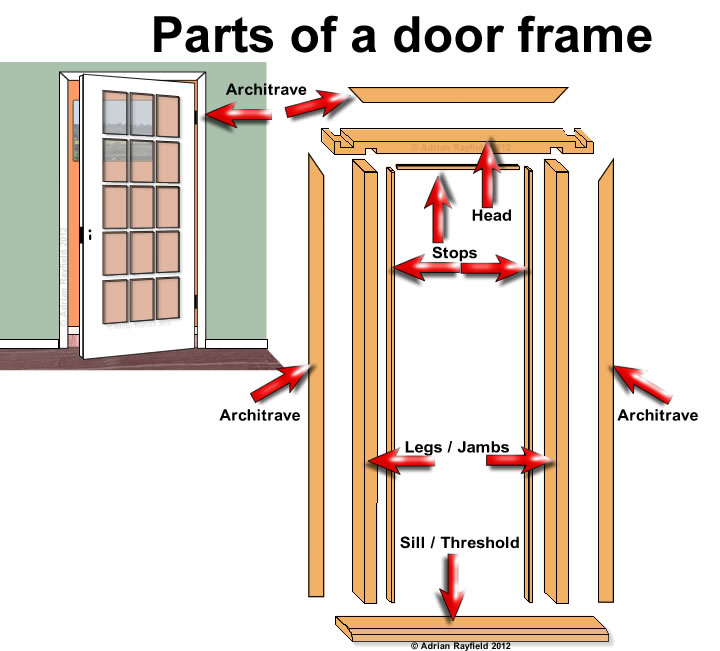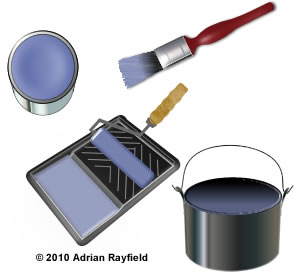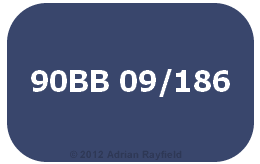Painting, decorating and home improvement tips blog
Parts of a door frame
Posted by Adrian
February 12th, 2013
Parts of a door frame
If you have ever been around a builder or in a timber yard or a DIY store you may of heard some terms that you are unsure of there meaning or what they are. You may think a door frame is just that, simply called a door frame. Well, you’ll be wrong, there are many parts that make up a door frame and I will explain them below.
A door frame is typically made out of wood for internal door frames, both hard and soft woods are used, hard wood such as oak is more expensive than the cheapest option of pine. External door frames can be made out of wood, metal or plastic, this will depend on the type of door you have. In this post I am talking about an internal soft wood door frame.

Door frame
An internal door frame is commonly made out of softwood such as pine, it is smooth planed timber and is known as a door frame, a door casing or door lining. It doesn’t matter what you call it, they are all the same thing. The frame comes in different depths to suit different wall thickness. The door frame is made up from several parts, a head, legs or Jamb, a sill or threshold and door stops. The frame is then finished off with a moulding called an architrave.
The door frame set
If you bought a new door frame you would buy a door frame “set” which includes all the parts to build the door frame, the set will have a head, two legs or jambs and door stops, you do not get any architrave in the set and will have to be bought separately. I will explain each part of the set below.
Door frame – head
The head is the top of the door frame, it allows to two side members of the frame, the legs/jamb to fit into a grove. The door frame head has grooves cut into it at two widths allowing you to choose the width of opening, if the inner groves are used the wood sticking out beyond the frame, known as horns, can be sawn off.
Door frame – legs / jambs
The door frame upright parts are called legs or jambs, in a finished frame one side has the hinges screwed into it and the other side has the door lock keep fitted to it. Some frame legs are rebated so a door stop isn’t required as the rebate makes the stop.
Door frame – door stop
The door stop is a thin piece of wood that is fixed to the inside of the leg / jamb, it’s job as the name suggests is to stop the door. With out a door stop the door can’t be halted and would rip of it’s higes. If the leg / jamb has a rebate a door stop isn’t required.
Door frame – sill / threshold
The door frame sill or threshold is the horizontal part at the bottom of the legs / jambs, this isn’t normally found in interior frames but can be seen on external door frames. It’s purpose is to give the frame rigidity and to help channel the water away as it runs off the door. It’s also the part you carry the bride over once you are married.
Architrave trim
Architraves are decorative mouldings. Not bought in a door frame set, these are bought separately as they come in different sizes and styles and can match your moulding on the skirting boards.
Tags: Architrave, Door, Door Frame, Door Frame Set, Frame, Head, Jamb, Legs, Stop
Posted in Decorating Tips | 6 Comments »
How do you paint a hall stairs and landing?
Posted by Adrian
January 13th, 2013

How do you paint a hall stairs and landing?
Painting a hall, stairs and landing for a lot of people is a daunting task and too much for them to tackle themselves, so they call a professional decorator like myself to do it for them. A lot of people will not have the ladder to aid them to reach the tallest part, or the stairs are an awkward shape.
Having the right tools makes it safe and easier to do, safety should always be in your mind when painting and decorating but especially if you are painting and decorating your hall, landing and stairs. Falling off a ladder whilst working on a stairway can be very painful.
Painting a hall, stairs and landing
Painting a hall, landing and stairs is just like painting any other interior room, you start at the top and work down.
So, start with preparing the walls, filling and holes and cracks, then paint the ceiling and coving, if you have any. Paint the picture rail next, if you have one, then emulsion the walls, if you have a dado emulsion down to that, then paint the dado before painting the remaining walls below the dado rail. This will save the newly painted wood work getting splashed with emulsion.
Finally, paint the stair stringers (the bit that goes up each side), the spindles and handrail and skirting boards.
And don’t forget the loft hatch if it’s in the hallway.
Wallpapering a hall, stairs and landing
If you are going to wallpaper your hallway, landing and stairs it is similar to wallpapering and interior room, you do all the preparation first, then you paint the ceiling and coving, then paint any woodwork such as picture rail, dado rail and the the stair stringers, spindles and handrail and also the skirting boards.
Once all the paint is dry, the final job is to wallpaper your hall, landing and stairs.
Useful links
Below is a list of useful links you may find help you when either painting or wallpapering your hallway, stairs and landing.
- Wallpaper calculator
- Paint calculator
- Ceiling wallpaper calculator
- How to wallpaper
- How to wallpaper around a door
- How to wallpaper around a window or door reveal
Please feel free to comment below, share this and other posts and follow us on our social media channels.
Tags: Ceiling Wallpaper Calculator, Decorating, Door, Hall stairs landing, Interior Decorating, Paint Calculator, Painting, Reveal, Skirting Boards, Wallpaper, Wallpaper Calculator, Wallpapering, Window
Posted in Decorating Tips | 6 Comments »
Colour trends for 2013
Posted by Adrian
December 18th, 2012
Colour trends for 2013
Dulux Colour Futures™ from AkzoNobel have gathered trends from all sorts of industries such as design, interiors, and fashion as well as social trends, economic trends and have come up with the upcoming trends for the coming year, through their international research they have selected a range of colours they think will be in trend throughout 2013.
Colour palettes and colour moods for 2013
The colour theme is being called ‘Connections’ as this is the
“one dominant influence or idea which inspired us to create the five colour trends”
Quote from ColourFutures™
The theme consists of the following five colour palettes and colour moods:
- Collective Passion
- Switching Off
- The Art Of Understanding
- Home Factory
- Visual Solace

What is to colour for 2013
The colour of the year 2013 is……. 90BB 09/186 (also known as Indigo Blue).
“Like the dreamy ocean landscapes hidden from everyone but deep sea divers, this colour gives us a sense of tranquillity and stability which is very restful. It’s a big and benevolent colour which combines the trustworthy nature and evocative elegance of robust blue.”
Quote from ColourFutures™
You can see more of this years colour schemes here:
Dulux Trade website or here:
http://www.colourfutures.com and download the Colour Futures book(PDF).
Paint Calculator
If you would like to use the colour of the year (90BB 09/186) or any other colour you need to buy and need to work out how much you need to buy, use our FREE Paint Calculator.
Tags: 2013, 90BB 09/186, AkzoNobel, Colour of the year, Dulux, Dulux Colour Futures, ICI, ICI Paints, Indigo Blue, Paint Calculator, Trends
Posted in Decorating Tips, News | No Comments »
